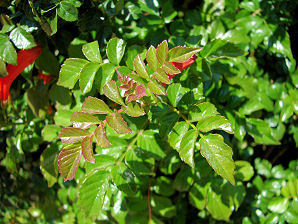Xeriscape Landscaping Plants For The Arizona Desert Environment.
Pictures, Photos, Information, Descriptions,
Images, & Reviews.
Shrubs.
Cape Honeysuckle, Tecomaria capensis.
We Are Proud Of Our SafeSurf Rating!
Click On Any Of The Following Links By Amazon.Com
For Books, & Videos About Wildflowers Of Arizona & The Southwest USA. No Obligation!
 |
| Cape Honeysuckle, Tecomaria capensis. March 15, 2006. Sun City, Arizona. |
|---|
 |  |
| Cape Honeysuckle. Tecomaria capensis. | Cape Honeysuckle. Tecomaria capensis. |
|---|
 /
/

Cape Honeysuckle.
We wish to thank Wikipedia, the free encyclopedia for some of the information on this page. We share images and information with Wikipedia. Cape Honeysuckle is a five to ten foot high shrub with pinnate leaves and racemes of orange-salmon funnelform 2 inch wide flowers. Native to South Africa. Hardy to at least 22�F. Commonly used for screening and decorative purposes. Attracts hummingbirds, creates a tropical effect.
Quick Notes:
Height: 5 - 10 feet tall, spread 4 to 6 feet.
Flowers: On terminal clusters of trumpet-shaped orange or red-orange flowers about 2 inches long.
Blooming Time: Late March to October.
Leaves: Leaves are pinnately compound; 4 inches long, dark green and glossy, with pointed serrate leaflets.
Found: The USDA claims Tecomaria capensis is native to the USA (FL), USA+ (PR). It is also native to South Tropical Africa: Mozambique. South Africa: Thr Eastern Cape, KwaZulu-Natal, Limpopo, Mpumalanga; & Swaziland. It is naturalized in Macaronesia: Spain: The Canary Islands; Australia: Queensland New Zealand; the South America Caribbean: Barbados; Cuba; Hispaniola; Jamaica; Puerto Rico. We have also seen it growing throughout Mexico, & Peru.
Elevation: Native from 600 to 2,500 feet.
Hardiness:
Soil pH requirements:
Sun Exposure:
Habitat: Alkaline, well-drained/light soils. An ideal landscape plant in Arizona.
Miscellaneous: Flowering Photos Taken March 15, 2006. Sun City, Arizona.
|



We Are Proud Of Our SafeSurf Rating!
Click On Any Of The Following Links By Amazon.Com
For Books, & Videos About Xerioscape Plants Of Arizona & The Southwest USA. No Obligation!
Back To Arizona Xeriscape Landscaping Main Page.
Back To Xeriscape Shrubs Page Three.
Back To Arizona Wild Flowers Home Page
Back To DeLange Home Page
© 1966 - Present, Audrey, Eve, & George DeLange
| © 1966 - Present, Audrey, Eve, & George DeLange |


